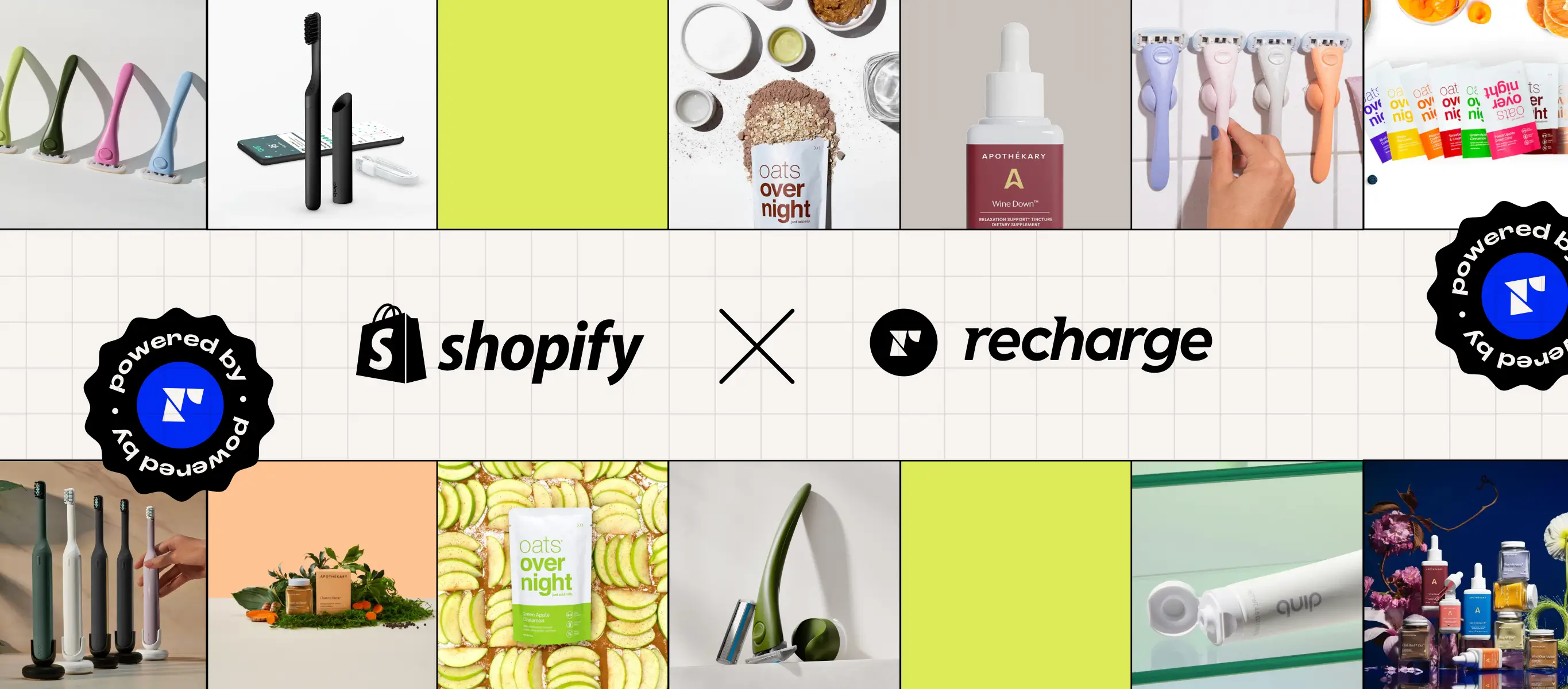The Blueprint for Brands
This limited series chronicles how today’s leading DTC brands came to define their markets: the ideas that sparked them, the decisions that grew them, and the tech that powered them.
Thirteen years ago, a moment of frustration in a drugstore shaving aisle set something big in motion. The simple desire to make shaving better has since snowballed into a family of brands that are reimagining their categories. Mammoth Brands (formerly Harry’s Inc.), the company behind personal care mainstays Harry’s, Flamingo, Lume, and Mando, is the largest CPG company built in the last two decades.
They constantly share learnings between their brands to ensure that each one can serve its customers as well as possible. Now they’re sharing their expertise with us. Mammoth Brands’ journey to the top of the industry is full of lessons for any brand—let’s take a look.
2012–2013: The early days
Smooth operator: Harry’s is founded to deliver affordable, high-quality grooming essentials
Like many brands, Harry’s was inspired by an unmet consumer need. The consumers: Harry’s co-founders Jeff Raider and Andy Katz-Mayfield. The need: shaving products that were approachable, affordable, and high quality.
Frustrated by a drugstore shaving aisle flanked with overpriced products with branding more appropriate for a spaceship than a razor blade, Andy found that little about the state of the shaving industry resonated with him. So he got in touch with his friend Jeff, who’d previously co-founded Warby Parker, and asked how he’d feel about creating a new shaving experience. Harry’s was born.
Custom-crafted: Harry’s enters the DTC market with a custom tech stack
Based on the personal motivations that inspired Harry’s (and on Jeff’s experience with Warby Parker, another DTC standout), the co-founders knew DTC was the right model for Harry’s. The direct connection to customers gave them invaluable insights on everything: product feedback, delivery times, even how often customers replaced their blades. Customer input guided decisions ranging from website redesigns to new product ideas.
In other words, they didn’t set out to pioneer the DTC space. That’s what they did in the end, of course, but it was simply the result of building for and around their customers. The customer-centric spirit still reigns at the company—members of the team, including Jeff and Andy themselves, still regularly take calls to connect with customers.
Early tech decisions shaped the customer experience
Harry’s early efforts at building their tech stack will sound familiar to many DTC brands: They considered the experience they wanted to deliver to customers, then evaluated the ecommerce platforms on the market to find one up to the task. Unfortunately, none of them were.
Much like Harry’s had responded to gaps in the shaving market by simply building better products themselves, they built their own custom tech stack based on Ruby on Rails. The custom tech enabled them to tailor every aspect of their experience to their (and their customers’) exacting standards. It had staying power, too—Harrys.com would run on that tech until 2024.
2014–2023: Growth—and growing pains
Made in Germany: Harry’s takes control of manufacturing with razor factory purchase
As the brand grew, it became clear that Harry’s would have to take manufacturing in-house to continue improving product quality while keeping up with demand. Though only a few factories in the world produced blades of the caliber they needed (and most of them were owned by competitors), they managed to partner with—and then buy outright—a 93-year-old razor blade factory in Germany less than a year after Harry’s launched.
The purchase gave Harry’s full control over their product (a recurring theme for the company) and transformed them into a global manufacturer overnight.
Bullseye: Harry’s lands on Target shelves & beats sales goals by 5x in two months
By 2016, Harry’s had earned over 3 million online customers and a devoted fanbase. They were ready for a big step forward: brick-and-mortar retail.
When choosing where to sell, they decided to meet their customers where they already shopped, and where they shopped was Target. Harry’s products hit Target’s site and shelves in 2016; the in-store configuration included 4 feet of dedicated aisle space aisle and an endcap display with an enormous orange cardboard razor.
The launch was a hit: In just two months, sales outpaced the forecast by 5x en route to becoming Target’s biggest personal care launch to date at that time.
Sharper moves: Flamingo and Harry’s Labs launches redefine the CPG landscape
Harry’s realized that their trajectory—building a brand online, fostering direct relationships with customers, entering retail disruptively—hadn’t been a fluke. On the contrary, they suspected that it was a repeatable playbook that other founders could follow to grow and scale their own visions.
To test their theory, they created Labs, an in-house incubation and acquisition engine; Flamingo, a women’s hair care and removal brand, emerged in 2018 and started to grow quickly.
The playbook worked. Harry’s vision of the modern CPG company was solidifying under Harry’s Inc., the umbrella over the Harry’s and Flamingo brands.
New tech makes incubation & launch more efficient
Just as important as following the playbook was understanding when to diverge, and Harry’s Inc. knew their existing Ruby on Rails ecommerce platform wouldn’t be the right fit for Flamingo. They also knew Flamingo would be just the first of many launches or acquisitions that would need a strong tech backbone.
When the market still didn’t offer a mature enough ecommerce platform off the shelf, they decided to invest in another homegrown platform. This one, built on a services-oriented architecture, would provide centralized back-end services like subscriptions, cart, and checkout for Harry’s Inc.’s various brands and storefronts to access via API.
Sound familiar? Yup—they were building their own version of Shopify.
A fresh take: Lume acquisition paves the way for more flexible tech
In 2021, Harry’s Inc. acquired the whole-body deodorant brand Lume, founded by Dr. Shannon Klingman. As a founder-led brand whose top-notch products had attracted a dedicated customer base, Lume had huge potential to scale (and more than a little in common with Harry’s). To preserve the magic behind Lume’s success, Harry’s Inc. left Klingman in charge and operating autonomously—they simply provided the playbook, infrastructure, and expertise that would help Lume grow.
Their hands-off philosophy paid dividends: In the 24 months after the acquisition, Lume grew 125% and even broke Harry’s record-breaking retail launch. The Labs group decided to capture that momentum by incubating Mando, the first dedicated men’s whole body deodorant brand—it’s been growing tremendously since launching in 2022.
Solving for scale: Harry’s merges parallel paths & stays nimble
Unsurprisingly, Harry’s Inc.’s growth from a single DTC brand into an international manufacturer and omnichannel retailer presented the company with some new challenges to manage. Even as they entered their partnership with Target, for example, they were expanding into new markets like the United Kingdom.
Adding new markets and channels multiplied the business’s complexity; soon they were introducing brand-new systems like an ERP (enterprise resource planning system) to centralize information and communicate with partners.
Their ecommerce tech was approaching its own inflection point too; while it had served Harry’s well so far, the company’s growing brand portfolio began to reveal that different brands would require different solutions.
Sandeep Chouksey joins as CTO to unify DTC and retail operations
While Harry’s envisioned itself as a truly omnichannel brand, its DTC and retail wings were drifting apart; customer and business data from either side lived in separate siloes, and it was becoming harder and harder to fuse them into omnichannel insights.
As a result, the two organizations started operating independently of each other, and it eventually became clear that they’d need to be unified. So in 2021, Harry’s Inc. appointed Sandeep Chouksey CTO and tasked him with building a unified omnichannel tech platform for the company.
Chouksey focused on merging the two parallel ecosystems’ data and operations into one source of insights and capabilities for the entire company—any brand, any channel. The new structure underpins all of their brands now, and is a key part of the company’s ability to scale new brands and acquisitions into successful omnichannel businesses.
Lume acquisition sparks ecommerce platform reevaluation
Harry’s Inc. may have lent its resources and expertise to Lume to help grow the brand after acquiring it, but the knowledge-sharing went both ways in the end.
Lume had been running on Shopify and Recharge for two years by the time of the acquisition. Though Harry’s homegrown ecommerce platform was now available to them too, it didn’t feel like the right fit for the brand; in fact, it was even missing some features that Lume and their customers used every day.
Harry’s believed in preserving the autonomy and character of the brands they acquired, which meant that pushing a new tech stack on to them—especially when it wouldn’t better equip them to serve their customers—was a non-starter. And with Shopify having become the platform of choice for most DTC brands, Harry’s realized that any future brands they acquired would likely be using it too.
The writing was on the wall—they would trade their in-house platform for Shopify.
2024–present: Unification & reinvention
Testing the water: Flamingo becomes the first to migrate
Moving every Harry’s Inc. brand to a new platform would require finesse. Rather than migrate all at once, the company started with Flamingo alone—it was a newer brand with less data to move, making it an easier test case.
The decision paid off. When the migration went smoothly, it solidified the company’s confidence not only in Recharge and Shopify, but in their own teams’ ability to handle even more complex migrations.
Welcome home: Harry’s Inc. unifies its brands on Shopify + Recharge
And migrating Harry’s to the new platform certainly was more complex. Where Flamingo had taken 3 months to migrate, Harry’s, with years’ more data to account for, took 8. But in February 2025, after 12 years on custom tech, Harry’s joined the other brands on Shopify and Recharge.
The new platform offers plenty of advantages, without compromising on the company’s ethos of letting its brands operate independently. They still spend plenty of time sharing insights with each other—a churn prevention strategy that works for one brand is certain to make its way to the others. And now that they share a tech toolset, it’s even easier to apply those insights or transfer talent between teams, making the company even more flexible.
A cut above: Harry’s Inc. rebrands to Mammoth Brands to mirror their diverse portfolio.
This far into their journey, Harry’s Inc. had become way more than just a razor company. In April 2025, they announced that Harry’s Inc. had become Mammoth Brands to reflect the company’s breadth and scale.
Big, formidable, and friendly, the Mammoth is a Harry’s icon that has appeared on the brand’s products for years. It was the natural choice for the parent company’s new identity.
The company’s core remains unchanged—their vision, operating model, and mission to Create Things People Like More still guide everything they do. Mammoth Brands is dedicated to improving the lives of consumers and building a home for brands, founders, and people who want to do the same.



